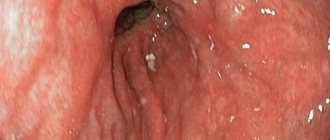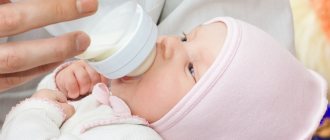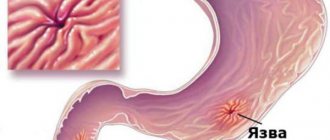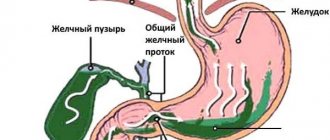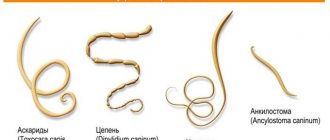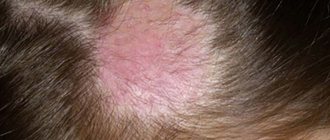Hemocolitis (hemorrhagic colitis) is an acute inflammatory process in the large intestine, accompanied by the appearance of blood in the stool. It is one of the key signs of ulcerative colitis and some other conditions.
It occurs in young children and has a fulminant symptomatic picture. Differential diagnosis is based on stool analysis, ultrasound and endoscopic methods. The prognosis depends entirely on the severity of the pathology and the degree of damage to the intestinal mucosa.
Cause of occurrence
Hemorrhagic colitis is a consequence of human infection with certain enterohemorrhagic strains of Escherichia coli. This disease can also be classified as enterohemorrhagic escherichiosis. Pathogenic bacteria infect the large intestine, their vital activity is accompanied by the production of a toxin (Shiga toxin). It is this substance that causes the development of bloody diarrhea and other serious complications.
There are several varieties of E. coli that can cause hemorrhagic colitis. Some of them are found in the digestive tract of healthy cattle. An outbreak of the disease can be triggered by:
- eating ground beef that has not been thermally processed sufficiently;
- eating unpasteurized milk;
- consuming food or water that contains fragments of cow manure or raw ground beef.
Sprouted seeds can become an unexpected source of infection. Raw plant sprouts are used by healthy eating enthusiasts, vegans, etc. But seeds can become infected with pathogenic E. coli in the field, as well as during transportation or storage. Therefore, it is better not to give this product to children. Adults should take it with special precautions.
Pathogens that cause enterohemorrhagic colitis can be transmitted from sick people to healthy people. Quite often, children in diapers become the source of infection. There are known cases of the disease developing after visiting water parks with insufficiently chlorinated water.
Shiga toxin attacks the mucous membranes of the colon, causing damage. If toxins enter the systemic bloodstream, they can harm other organs, such as the kidneys.
Image: Artemida-psy / Shutterstock.com
Haemorrhoids
This disease is expressed in the pathological expansion of hemorrhoidal veins, which is accompanied by thrombosis and inflammation. As the disease develops, specific nodes form on the inner walls of the rectum and on its outer part. The causes of this disease are:
- slowing blood circulation in the hemorrhoidal plexuses;
- blood stagnation in the pelvic organs.
Against the background of blood circulation disorders, the vessels in the rectum begin to become very stretched and deformed. Such changes entail inflammatory processes in the hemorrhoids, which swell and increase in size. This makes defecation very difficult. To empty the full intestines, you have to push hard, which in turn causes the nodes to partially come out or even fall out completely. This is also facilitated by strong blood pressure in the vessels of the rectum. In this case, bleeding and sharp painful sensations may occur.
https://youtu.be/8_kreSGQy1g
Signs of illness
The incubation period lasts from 2 to 4 days. Enterohemorrhagic colitis begins suddenly and acutely. The patient is concerned about:
- watery, frequent stools (up to 4-5 times a day), in which there is no blood;
- nausea and vomiting, sometimes repeated;
- severe painful abdominal cramps (colic);
- imperative urge to defecate (tenesmus);
- during the day - frequent loose stools with obvious traces of blood;
- in severe cases - stool consisting of mucus and blood.
Diarrhea with hemorrhagic colitis can last for 24 hours; sometimes this symptom bothers the patient for up to 8 days in a row. Temperatures, as a rule, remain normal or do not exceed 37.5 °C. Occasionally the temperature rises to 38-39 °C or even exceeds this figure.
Hemorrhagic colitis can even develop in young children who cannot explain what is bothering them. The child begins to cry loudly, worry and tuck his legs. As a rule, children refuse to eat.
The concept of eoinophilic colitis
Eozonophilic colitis refers to manifestations of an allergic reaction to food products. This pathological process is characterized by the addition of gastroenterocolitis. The disease can occur in adults and children aged fourteen to seventy-five years. For the most part, it is the female half of the population that suffers from the disease.
The main symptoms of the disease include:
- painful feeling in the abdomen. At the same time, they resemble a spastic character;
- nausea and vomiting;
- diarrhea;
- the appearance of blood in the stool.
To prevent eosinophilic colitis from leading to further complications, you need to consult a specialist as soon as possible. He will conduct a detailed examination and prescribe appropriate treatment.
Diagnostics
If symptoms of hemorrhagic colitis occur in a child, it is necessary to seek medical help as soon as possible. To confirm the diagnosis, the doctor:
- examines the patient;
- collects anamnesis;
- prescribes standard (“general”) blood and urine tests;
- sends a stool sample to a laboratory to look for E. coli strains or toxins.
Photo: plenoy m / Shutterstock.com
To clarify the diagnosis, the doctor may also prescribe other diagnostic procedures. An endoscopic examination is performed to visually examine the intestines.
Types of enterocolitis
According to the nature of the course, acute and chronic enterocolitis are distinguished.
Based on location, localized or generalized forms are distinguished:
Based on their origin, the following types of enterocolitis are distinguished:
- Infectious bacterial origin caused by intestinal infection: pathogenic strains of Escherichia, Salmonella, Shigella, Vibrio cholerae, Staphylococcus, etc. Staphylococcal enterocolitis in newborns and infants is most common;
- Infectious parasitic origin. Causative agents of amoebic dysentery, intestinal helminths of all types, Trichomonas, Giardia, etc. are the cause of parasitic enterocolitis;
- Enterocolitis developed as a result of dysbacteriosis. One of the most common types of colitis;
- Toxic enterocolitis. This group of diseases is caused by toxic substances entering the intestinal mucosa: drugs, poisons, including those contained in poor-quality food products;
- Mechanical enterocolitis caused by injury to the intestinal mucosa; as a rule, injury is caused by compacted stagnant feces in chronic constipation;
- Alimentary enterocolitis, which occurs due to constant gross errors in nutrition, unbalanced nutrition;
- Secondary enterocolitis, occurring as one of the symptoms of another, underlying disease. For example, enterocolitis accompanying cholecystitis, which is formed due to a violation of the outflow of bile.
Treatment regimen
Patients with suspected escherichiosis are hospitalized in the inpatient department of the hospital. In case of severe infection, treatment may be carried out in the intensive care unit. When uncomplicated, hemorrhagic colitis goes away on its own. The main key to successful recovery is active rehydration. Frequent loose stools lead to severe dehydration. This is dangerous for patients of any age, but for babies this loss of moisture can be critical. To avoid sad consequences, doctors prescribe drinking a sufficient amount of fluid (in the form of ordinary water and special saline solutions, for example, Regidron). Intravenous infusions of solutions to restore water-salt balance are carried out in case of severe fluid loss and the inability to give the baby something to drink.
To alleviate the condition of a sick child, antispasmodics are used. Such medications help relieve colic and eliminate pain. After diarrhea stops, doctors prescribe eubiotics to correct the intestinal microflora.
Enterocolitis
Enterocolitis is inflammation of the intestines. This term has two components - enteritis, or inflammation of the small intestine, and colitis, or inflammation of the large intestine. Since the entire intestine is a communicating tube, then, as a rule, there is no isolated colitis or isolated enteritis, since the process that began in one section inevitably spreads to another. In the early stages of the disease, however, both limited enteritis and limited colitis are possible, but this is not of great importance for treatment, since the complex of therapeutic measures is aimed at treating enterocolitis as a whole.
Antibiotics in the treatment of hemorrhagic colitis
It would seem that colitis caused by bacteria should be successfully treated with antibacterial drugs. However, in the case of hemorrhagic eschirichiosis, doctors prefer not to use antibiotics. This is due to several factors:
- Strains of E. coli that lead to the development of hemorrhagic colitis are resistant to many antibiotics.
- Studies have shown that antibiotic treatment does not affect the outcome of the infection (does not speed up recovery).
- There is evidence that antibiotics may increase the risk of complications (hemolytic-uremic syndrome).
In case of severe and/or long-term course of escherichiosis, doctors can only prescribe carbapenems, for example, ertapenem (acts systemically - throughout the body) or rifaximin (acts exclusively in the gastrointestinal tract, is not absorbed into the blood).
| A drug | Rifaximin | Ertapenem |
| How does it work? | Inhibits the enzyme of bacterial cells, causing their death. Suppresses pathogenic intestinal flora, reduces the production of toxic compounds by bacteria. | Suppresses bacterial cell wall synthesis and binds to penicillin-binding proteins. |
| Application diagram | The safety and effectiveness of the drug for children has not been confirmed by clinical studies. The possibility of use is determined by the doctor. Dosage for children over 12 years of age: 10 ml of suspension at intervals of 6 hours. | Used for intravenous or intramuscular administration. The drug can be used to treat children from 3 months of age. The dosage is calculated depending on the patient's weight. |
Enterocolitis
Enterocolitis is the general name for diseases of the digestive tract, during which simultaneous inflammation of the mucous membrane of the small and large intestines occurs. This is a long-term disease, the occurrence of which can be associated with many reasons.
Classification of enterocolitis
Enterocolitis can be either acute or chronic.
Acute enterocolitis
most often develops together with acute gastritis (this disease is called gastroenterocolitis). Usually, in the acute form of the disease, the inflammatory process affects only the mucous membrane and does not spread to the deeper layers of the intestine.
Medicines to restore microflora
After an illness, a child needs a complete diet. The diet will help restore the normal state of the mucous membranes of the digestive tract. To normalize intestinal microflora, doctors can prescribe the following drugs:
| A drug | Bifidumbacterin forte | Hilak forte |
| Compound | Bifidobacteria sorbed on activated carbon. | Metabolic products of normal microflora, biosynthetic lactic acid and its buffer salts. |
| Children's release form | Powder for oral administration. | Drops for oral administration. |
| Action | Immunomodulatory, improves digestion, stabilizes intestinal microflora. | Helps restore intestinal microflora naturally, restores normal acidity, stimulates the regeneration of the intestinal wall and the immune response. |
| Mode of application | The medicine is intended for internal use during meals. The powder must be mixed with a liquid product, for example, fermented milk. For young children, it is given along with breast milk or formula. The powder can be mixed with water; drink until completely dissolved. | The medicine is intended for internal use shortly before or during meals. The drops must be diluted with a small amount of liquid (not milk). |
| Dosage | For children under 12 months - 1 sachet 2-3 r. per day. For children from 12 months - 1 sachet 3-4 rubles. per day. | For children under one year - 15-30 drops 3 r. per day. For children from one year old - 20-40 drops 3 rubles. per day. |
| Duration of admission | From 7 to 21 days. | Determined by a doctor. |
Enterocolitis
Enterocolitis is inflammation of the intestines.
This term has two components - enteritis, or inflammation of the small intestine, and colitis, or inflammation of the large intestine. Since the entire intestine is a communicating tube, then, as a rule, there is no isolated colitis or isolated enteritis, since the process that began in one section inevitably spreads to another. In the early stages of the disease, however, both limited enteritis and limited colitis are possible, but this is not of great importance for treatment, since the complex of therapeutic measures is aimed at treating enterocolitis as a whole. Enterocolitis is the most common disease of the gastrointestinal tract; enterocolitis is especially common in children. There is probably not a single person who has not experienced the symptoms of acute enterocolitis. This is what is popularly called "indigestion" or "stale food poisoning."
The danger of hemorrhagic colitis
Colitis with bloody stools can lead to a serious complication - hemolytic-uremic syndrome. This condition develops in approximately 5-10% of patients. The risk of its occurrence in children under 5 years of age is quite high. In hemolytic uremic syndrome, small blood clots form in the blood vessels, obstructing the flow of blood to vital organs. Blood flow may even be completely blocked.
Hemolytic-uremic syndrome may occur in the second week of hemorrhagic colitis. Sometimes this condition develops after a preliminary increase in temperature. Typically for this complication:
- The occurrence of anemia. This condition is manifested by increased fatigue, pronounced weakness of the child, and severe pallor of the skin. Anemia is caused by the destruction of blood cells - red blood cells - passing through partially blocked vessels.
- Decreased platelet levels. A huge number of such cells are used to form blood clots, so the total volume of platelets in the bloodstream decreases.
- Sudden renal failure. Its onset can be suspected by swelling of the skin and subcutaneous tissue, decreased daily urination (up to complete cessation), disturbances of consciousness, and convulsive attacks.
Hemolytic-uremic syndrome is an extremely serious condition, with a typical mortality rate of 3-7%. If this complication leads to kidney failure, the patient requires dialysis (a procedure that replaces kidney function). Very rarely, hemolytic uremic syndrome leads to damage to the nerves or brain, which is manifested by seizures or strokes.
Possible consequences of pathology and prognosis for life
With adequate and timely treatment, the disease rarely causes serious harm to the child’s health, but the risks of complications still remain. The following complications are known in clinical practice:
- hemorrhagic nephritis;
- development of renal failure;
- convulsions;
- hemolytically caused anemia;
- blood diseases associated with changes in blood composition;
- damage to the nervous system (a complication caused by excessive release of toxin as a result of the pathogenic activity of bacteria).
We recommend reading:
Gastroenterocolitis: symptoms and treatment methods (diet, medications)
The prognosis is usually favorable, depending on timely treatment. If the pathology is caused by abnormalities in intestinal development, polyps, then surgical correction must be performed to avoid the risk of relapse.
Prevention
Photo: YAKOBCHUK VIACHESLAV / Shutterstock.com
To avoid the development of hemorrhagic colitis in children and adults, doctors recommend:
- subject meat products to full heat treatment;
- drink pasteurized milk and eat only pasteurized dairy products;
- observe the rules of hygiene, wash your hands thoroughly and often with soap;
- use different cutting boards in the kitchen (one for ready-to-eat foods, one for raw foods);
- treat containers intended for transporting food with boiling water.
The development of dangerous intestinal infections can most often be avoided only by observing basic hygiene rules.
Types of enterocolitis
According to the nature of the course, acute and chronic enterocolitis are distinguished.
Based on location, localized or generalized forms are distinguished:
Based on their origin, the following types of enterocolitis are distinguished:
- Infectious bacterial origin caused by intestinal infection: pathogenic strains of Escherichia, Salmonella, Shigella, Vibrio cholerae, Staphylococcus, etc. Staphylococcal enterocolitis in newborns and infants is most common;
- Infectious parasitic origin. Causative agents of amoebic dysentery, intestinal helminths of all types, Trichomonas, Giardia, etc. are the cause of parasitic enterocolitis;
- Enterocolitis developed as a result of dysbacteriosis. One of the most common types of colitis;
- Toxic enterocolitis. This group of diseases is caused by toxic substances entering the intestinal mucosa: drugs, poisons, including those contained in poor-quality food products;
- Mechanical enterocolitis caused by injury to the intestinal mucosa; as a rule, injury is caused by compacted stagnant feces in chronic constipation;
- Alimentary enterocolitis, which occurs due to constant gross errors in nutrition, unbalanced nutrition;
- Secondary enterocolitis, occurring as one of the symptoms of another, underlying disease. For example, enterocolitis accompanying cholecystitis, which is formed due to a violation of the outflow of bile.
Folk remedies
In the treatment of hemorrhagic colitis, folk remedies that are used in the form of decoctions, infusions and enemas have proven themselves well. It is important to remember that any use of medicinal plants should begin after consultation with your doctor. Let's look at the most common of them:
- yarrow;
- bird cherry berries;
- ginger;
- plantain;
- shepherd's purse.
Most often they are used in the form of decoctions and tinctures.
For enemas, you can use diluted rosehip or sea buckthorn oil, as well as decoctions of St. John's wort or chamomile.
Diet
The therapeutic diet for enterocolitis involves dietary restrictions.
Added to the menu:
- rice broth;
- porridge with water;
- food in the form of puree without adding salt and fat;
- healing herbal decoctions;
- strengthening infusions;
- weak tea.
The purpose of a diet for enterocolitis is determined by a number of factors:
- site of gastrointestinal tract lesion;
- type of processes occurring;
- nature of the disorders.
If the small intestine is affected, the diet includes proteins, B vitamins, and minerals. During putrefactive transformation processes, the amount of protein is reduced, the consumption of coarse fiber and fermented milk products is reduced.
If fermentation processes dominate, you should eliminate from your diet:
- black bread;
- cabbage;
- whole milk;
- pickles;
- beans;
- sweet;
- salty and spicy, etc.
You need to eat fractionally, several times a day in small doses. The energy value of the food consumed should be about 1500 kcal, drinking fresh water in a volume of at least 1.5 liters. For medicinal purposes, they eat boiled food, baked in the oven without fat, and steamed food.
The main thing is that it satisfies the patient’s tastes, so that he can more easily endure forced restrictions.
How to switch to a regular diet correctly
To prevent the acute process from becoming chronic, it is recommended to follow the sequence of diet expansion. After diet 4, the following foods and dishes are added to the diet:
- soup in a weak broth of meat, fish, vegetables. Small noodles or vermicelli, pureed cereals and vegetables, and meatballs are poured into it;
- dried white bread (yesterday's), biscuits, dryers;
- milk and cream are used for sauces, soups, porridge (half diluted with water);
- low-fat homemade cottage cheese, kefir and yogurt are recommended to be made independently from milk and pharmacy starter cultures;
- mild cheese is added to dishes;
- only minced meat or beef stroganoff. First, the skin is removed from the bird, all films and tendons are removed;
- lean fish is steamed, boiled in water or used for steamed cutlets, meatballs, soufflés;
- From vegetables, the most digestible ones are first selected - seedless zucchini, cauliflower, pumpkin, potatoes and carrots;
- All previously permitted porridges remain; boiled vermicelli is also prepared as a side dish;
- You can add a little fresh herbs to dishes for taste;
- baked apples, boiled pears. gradually try fresh sweet fruits without skin;
- compotes, jelly, berry and fruit mousse;
- diluted juice of apples, tangerines, oranges, cherries.
Symptoms of the disease
Today, almost half of the adult population has problems with the large intestine. A common pathology is chronic colitis, the symptoms of which are sometimes almost invisible. With this disease, the intestinal mucosa is affected and dystrophy begins, so treatment with medications in combination with folk remedies should be started immediately.
Pain from proctalgia can radiate to the intimate area.
Proctalgia is a pathological deviation of the muscular system of the rectum. Manifestations of the problem:
- acute pain attacks radiating into the intimate area and across;
- painful bowel movements;
- pain symptom that disappears when taking a bath;
- spasms occur at night.

